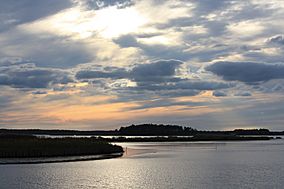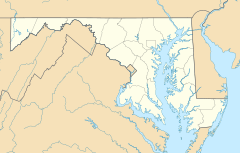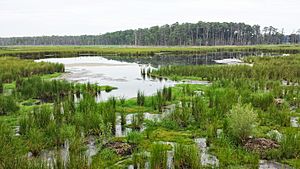Blackwater National Wildlife Refuge facts for kids
Quick facts for kids Blackwater National Wildlife Refuge |
|
|---|---|
|
IUCN Category IV (Habitat/Species Management Area)
|
|

View from the wildlife drive after a storm.
|
|
| Location | Dorchester County, Maryland, USA |
| Nearest city | Cambridge, Maryland |
| Area | 28,894.35 acres (116.9313 km2) |
| Established | 1933 |
| Website | Blackwater National Wildlife Refuge |
The Blackwater National Wildlife Refuge is a special place created in 1933 to protect birds. It's a safe home for many birds that travel along the Atlantic Flyway, a major migration route. This refuge is found on Maryland's Eastern Shore, about 12 miles (19 km) south of Cambridge, Maryland. It's located in Dorchester County.
Blackwater Refuge covers more than 28,000 acres (110 square kilometers). This huge area includes different types of land. You'll find freshwater ponds, salty wetlands, open fields, and forests with both evergreen and leafy trees. The refuge is part of the National Wildlife Refuge System, which has over 540 similar places across the USA. The United States Fish and Wildlife Service manages these important areas.
The refuge gets its water from the Blackwater River and the Little Blackwater River. The name "blackwater" comes from the dark, tea-like color of these rivers. This color happens because the water flows through peat soil in the marshes, picking up a natural substance called tannin.
Contents
What Animals Live Here?
Blackwater Refuge is a lively home for many different animals and plants. It has lots of wetlands and forests. Over 250 kinds of birds live here, along with 35 types of reptiles and amphibians. You can also find 165 species of rare or endangered plants. Many mammals also call this refuge home.
During the winter, when birds travel south, Blackwater Refuge becomes a temporary home for thousands of geese and ducks. Sometimes, more than 15,000 geese and 10,000 ducks visit! The refuge has helped three species recover: the Delmarva fox squirrel, the peregrine falcon, and the bald eagle. These animals were once endangered but are now doing much better.
Mammals of Blackwater
Many different mammals live at Blackwater Refuge. One animal that used to cause problems was the nutria, a rodent from South America. It was brought to the refuge in the 1930s. However, thanks to a big effort to trap them starting in 2002, nutria are now almost gone from the area.
The Delmarva fox squirrel is another important mammal here. It was once an endangered species. The refuge has special programs to manage its forests, which helps protect these squirrels.
Here are some of the mammals you might find at Blackwater National Wildlife Refuge:
- Gray squirrel
- Delmarva fox squirrel
- Muskrat
- Opossum
- Eastern cottontail rabbit
- Red fox
- Gray fox
- River otter
- Beaver
- Raccoon
- White-tailed deer
- Sika deer
Reptiles and Amphibians
The marshes and swamps at Blackwater are perfect places for many reptiles and amphibians to live. These wet areas provide everything they need to survive.
Some of the reptiles found at Blackwater Refuge include:
- Eastern painted turtle
- Eastern box turtle
- Snapping turtle
- Northern diamondback terrapin
- Northern fence lizard
- Black rat snake
- Eastern garter snake
- Northern water snake
- Northern copperhead
And here are some of the amphibians that live here:
- Marbled salamander
- Red back salamander
- Fowler's toad
- Northern cricket frog
- Northern spring peeper
- Green treefrog
- Bullfrog
- Southern leopard frog
Birds of the Refuge
Blackwater Refuge is a very important feeding spot for birds that are migrating. The Canada goose is one of the most common birds you'll see here. You can also find swans, cranes, and more than 20 different kinds of ducks in the water.
The bald eagle is another special bird at the refuge. Blackwater has one of the largest groups of nesting bald eagles on the Atlantic coast. During winter, many eagles fly to Blackwater from northern states and Canada. In total, over 200 types of birds use the refuge as a resting place.
Some common birds you might spot at Blackwater Refuge are:
- Canada goose
- Wood duck
- Mallard
- Great blue heron
- Turkey vulture
- Osprey
- Bald eagle
- Red-tailed hawk
- Killdeer
- Mourning dove
- Blue jay
- American crow
- American robin
- Northern mockingbird
- Northern cardinal
- Red-winged blackbird
- American goldfinch
Bald Eagles: A Success Story
The bald eagle is the most famous animal living at Blackwater Wildlife Refuge. This refuge is home to the largest group of bald eagles that breed (have babies) on the East Coast, north of Florida. In winter, even more eagles fly here from colder places like Canada.
You can even watch a live Eagle Cam on the Friends of Blackwater website. It shows an eagle nest right in the refuge! The Friends of Blackwater also have an Osprey Cam where you can follow a pair of ospreys during spring and summer.
Visiting Blackwater Refuge
Blackwater National Wildlife Refuge offers many fun ways to explore and enjoy nature. Even though much of the refuge is wetlands, there are still lots of ways to see the wildlife and beautiful scenery up close.
The refuge has a Visitor Center on Key Wallace Drive. Inside, you'll find exhibits about wildlife, a real eagle's nest, and TV screens showing the Eagle Cam and Osprey Cam. There's also a gift shop, restrooms, and maps to help you plan your visit. On the second floor, the "Wild Birds Unlimited Pathways to Nature Observatory" has more bird exhibits and special scopes to view the Blackwater River and the marsh. The Visitor Center staff also offer educational programs for kids and lead bird walks. They even have an annual Eagle Festival!
The best way to see the heart of Blackwater Refuge is by taking the Wildlife Drive. This is a paved road, about 3.5 miles (5.6 km) long, or a 6.5-mile (10.5 km) loop. It takes you along the Blackwater River and gives you amazing views of the local wildlife. You can drive, bike, or walk along the Drive.
There is a small daily fee to use the Wildlife Drive: $3.00 for private cars and $1.00 for people walking or biking. You can also buy longer passes, like annual passes or a senior citizen pass.
Besides the Visitor Center and Wildlife Drive, Blackwater Refuge has three paddling trails for boats, and four hiking trails. You can also go hunting, fishing, and crabbing in certain areas. There are other ways to drive through the refuge without using the Wildlife Drive.
About half of the refuge is part of the Harriet Tubman Underground Railroad National Monument. In 2014, some of this land was given to the National Park Service to become the Harriet Tubman Underground Railroad National Historical Park.
Who Helps at the Refuge?
The staff at Blackwater Refuge get a lot of help from the Friends of Blackwater. This is a non-profit group of citizens who volunteer many hours at the refuge. They also support different programs and projects throughout the year. In 2003, the Friends of Blackwater were even named the "Friends Group of the Year" for their amazing work!
Images for kids








